
Switzerland - WAB Wengernalpbahn
For a full scale picture, please click on the picture shown !
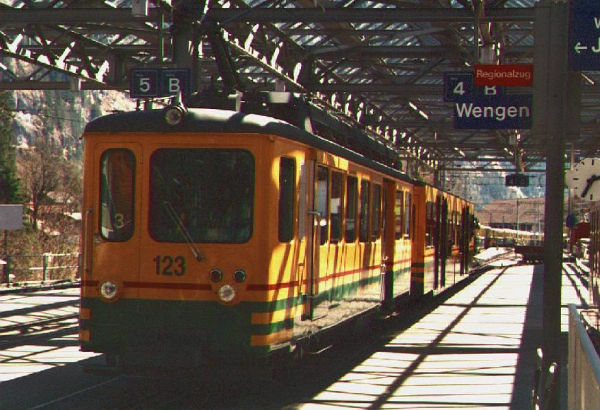
Wengernalpbahn WAB takes people and goods from the villages of Lauterbrunnen and Grindelwald reachable by cars up to the carless
villages of Wengen and Kleine Scheidegg and further to the Jungfraubahn railroad from Kleine Scheidegg (2061m) up to Jungfraujoch
(3475m). Wengernalpbahn forms with its around 20 km of route length the biggest continuous network of pure rack railway operation
in the world. The Jungfraubahn is the railroad which reaches the highest altitude in Europe. Both lines are owned and operated
by Jungfraubahn Holding and its subsidiaries. As the area served by these railways, with the exception of the starting points at
Lauterbrunnen and Grindelwald, do not have a road connection, the lines serve many kinds of needs. This is especially true for
the short section from Lauterbrunnen to Wengen, as Wengen has several thousands of year-around inhabitants in addition to its
role as a tourist destination.
Wengen is a famous ski village with even European Cup ski events; there is also a marked need for goods transport, which is all
handled by the WAB trains. Wengernalpbahn is built with 800 mm gauge. It is throughout built with a rack rail system according
to the so called Riggenbach rail system. Maximum incline slope is 250 promilles or 25%. There are ten stations along the line.
The electric system is 1500 V DC from an overhead catenary line.
The car free village of Wengen can only be reached by the the cog wheel, rack rail
Wengernalpbahn from Lauterbrunnen. It operates like a tram, just slower. Here a WAB
BDhe 4/4 2. series no. 123 from 1970 in pair with a more modern 1998 built
unmotorised wagon no.243 at Lauterbrunnen station, just about to leave to Wengen.
Photo in May 1999 by Ilkka Siissalo.
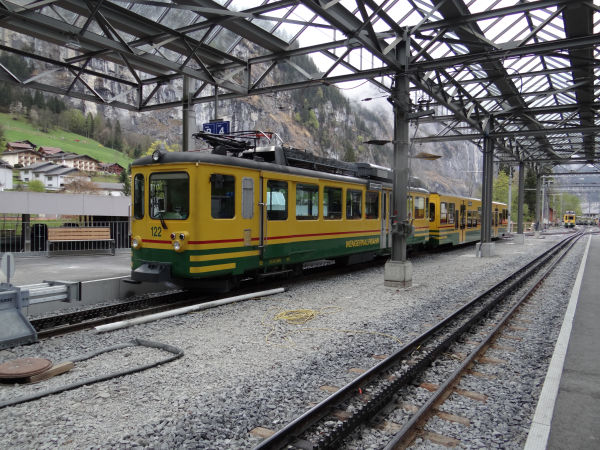
A similar composition like the one pictured above, this is the motorwagon BDhe 4/4 no.122 from 1970
together with a new low-floor motorless steering cab coach.
Photo from Lauterbrunnen station in 1.5.2016 by Ilkka Siissalo.
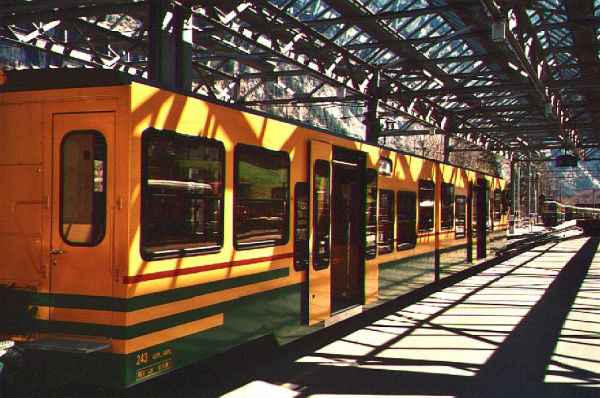
The Wengernalpbahn no. 243 is a motorless steering cab coach type of a unit consisting of
two coaches, permanently attached. This new wagonset was built in November 1998 and it was
the first low floor, tram-like train of WAB. Climbing on the snowy, steep hillsides
along WAB´s cog wheel three rail railroad it looks like a thing of the future in the wrong place.
Photo from Lauterbrunnen station in May 1999 by Ilkka Siissalo.
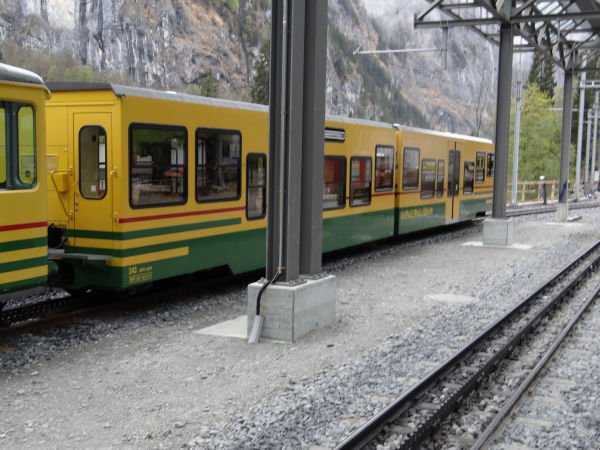
A closer look at the motorless new low-floor wagon no.243. It has a bending joint in the middle to help it to turn in the tight
curves of the Wengernalpbahn route.
Photo from Lauterbrunnen station in 1.5.2016 by Ilkka Siissalo.
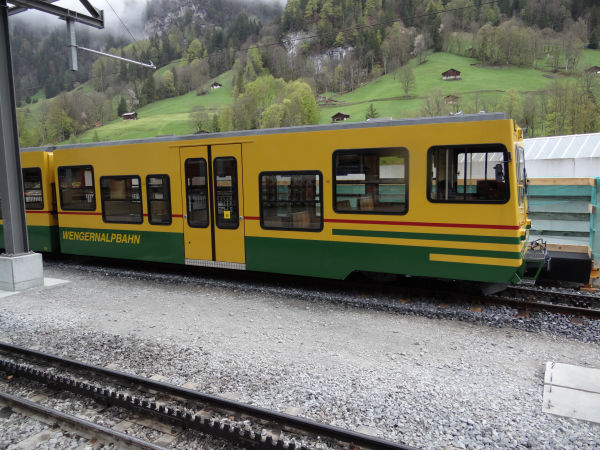
The front part of the same motorless wagon no.243 as shown above.
Photo from Lauterbrunnen station in 1.5.2016 by Ilkka Siissalo.
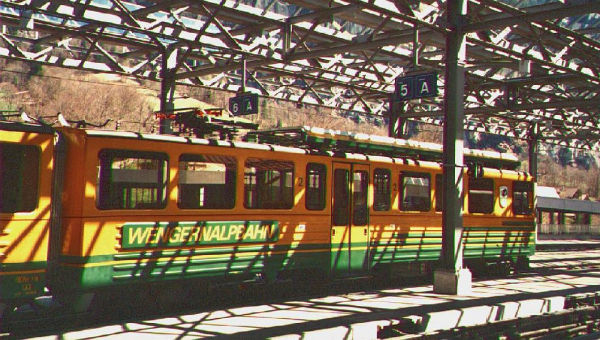
This BDhe 4/8 no 133 of WAB was built in 1988. It consists of two coaches, permanently
attached to each other. Both coaches are motorised but only the one shown here has a pantograph for
electricity. The two coaches weigh together 43 tonnes and this combination can climb the steep
slopes at a maximum of 28 km/h. There´s a large cargo compartment for skis and other goods.
Photo from Lauterbrunnen station in May 1999 by Ilkka Siissalo.
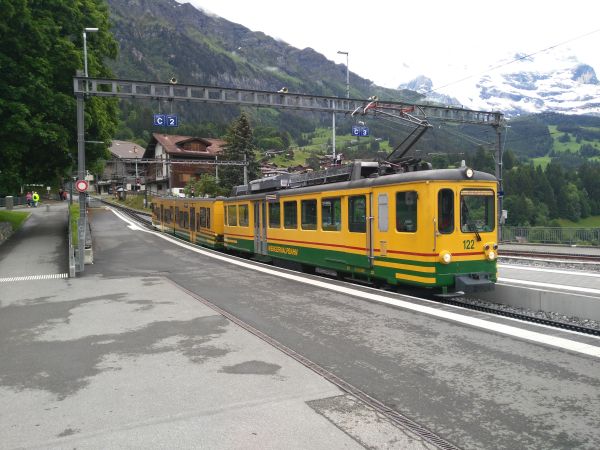
Wengernalpbahn is in the process of fleet renewal. In spite of this, some of the older equipment are still
expected to serve for many years to come. This includes the EMUs BDhe 4/4 120 to 123 from 1970 that have been
modernised thoroughly in two stages between 1998 and 2011, including asynchronous motors and equipment for
operation with low floor trailers. This is the same BDhe 4/4 122 as shown above, again now with a new low floor steering cab
trailer coach, which was also seen in the pictures above.
Picture from Wengen on 22.6.2019 by Johannes Erra.

The older livery of Wengernalpbahn was green below the windows and yellow around them. The majority of the EMUs changed colours
in the early 2000s, but some of the older units still have the old colours. These include the remaining units of BDhe 4/4
series 101 to 118, built between 1947 and 1964. Motor wagon BDhe 4/4 113 is seen here with its trailer, serving as a standby
unit at Kleine Scheidegg on 22.6.2019. The motor wagon is very similar to how the somewhat newer BDhe 4/4 120 to 123 looked like
before their modernisations. Most of the older units are expected to be retired from service during the early years of 2020s.
Picture from Kleine Scheidegg 22.6.2019 by Johannes Erra.
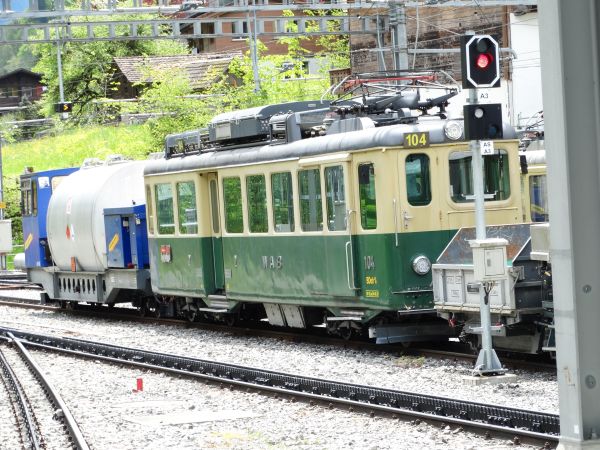
BDeh 4/4 no.104 is from the long series of eight motor wagons purchased by the Wengernalpbahn more or less similar during the years
1947 to 1964. Today these old motorwagons, if they have not yet been scrapped, they act as pure locomotives to bring goods to the villages
like Wengen where no roads lead to. This is the case also here. In front we see a large tank wagon with a driver's cab but no engine and
this old motor wagon is about to start pushing it uphills. In this case the tank is full of heating oil and it's presumabely being pushed up
to Wengen (or Kleine Scheidegg) for warming the houses up there.
Picture from Lauterbrunnen 13.5.2023 by Ilkka Siissalo.
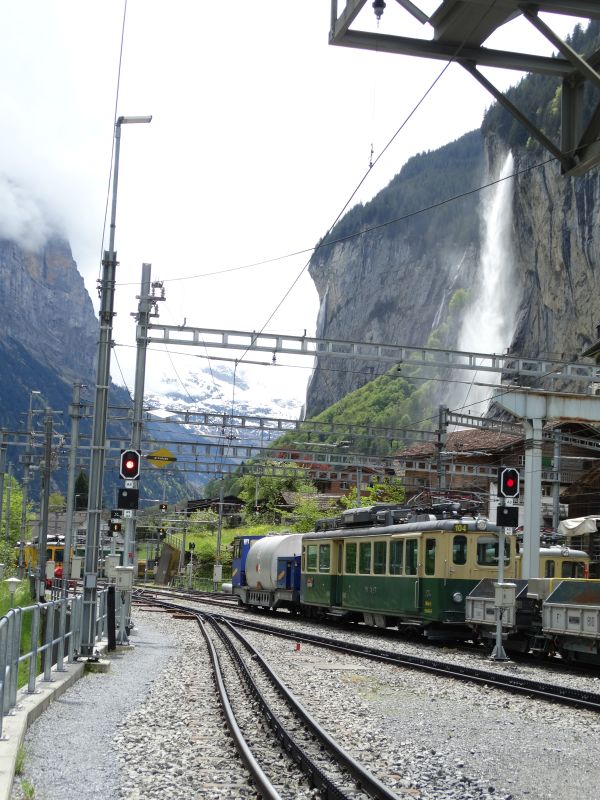
The same train as above, but now also showing the magnificient view around in Lauterbrunnen.
Picture from Lauterbrunnen 13.5.2023 by Ilkka Siissalo.
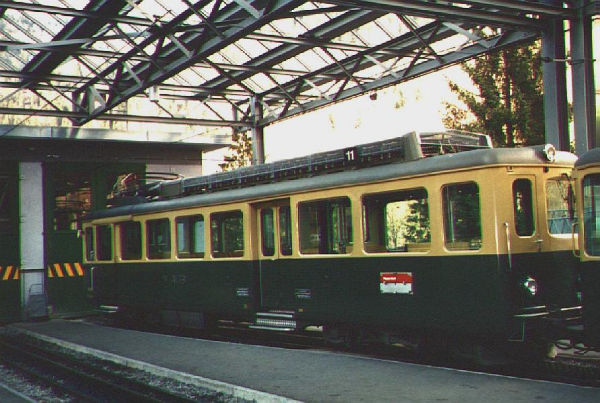
Wengernalpbahn WAB BDhe 4/4 (later BDeh) 2.series cog wheel electric motor unit no. 121
from 1970 at the Lauterbrunnen station. These EMUs were almost identical
to the 1964 built 1.series wagons like the one shown above, except for a bigger windscreen and a
bigger compartment for skis and luggage. Five of these EMUs used to operate to
the Kleine Scheidegg sking resort, 2061 m above sea level.
Photo from Lauterbrunnen station in May 1999 by Ilkka Siissalo.
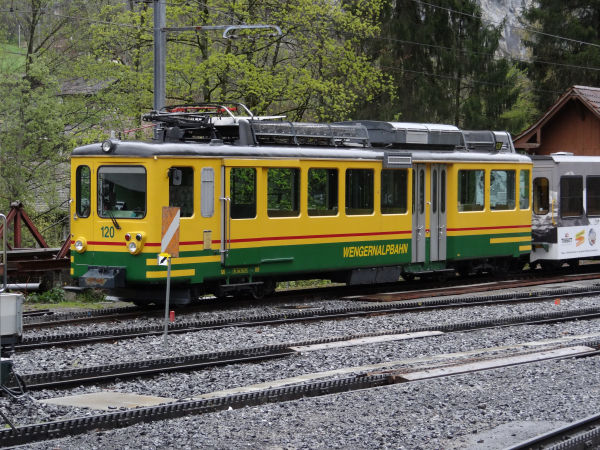
WAB BDeh 4/4 2.series no. 120
is from the same production series than the nos.121-123 shown above, but here in 2016 this no.120 had already
been thoroughly rebuilt and modernised, whereas the picture above shows the train pretty much in its original
state and livery.
Photo from Lauterbrunnen station 1.5.2016 by Ilkka Siissalo.

BDeh 4/4 no.107 is from the very first production series of electric multiple units of WAB. This
series was built during 1947-1958. This one is not normally used any more in passenger traffic, but it often hauls cargo loads up to Wengen and Kleine Scheidegg.
Picture from Lauterbrunnen 1.5.2016 by Ilkka Siissalo.
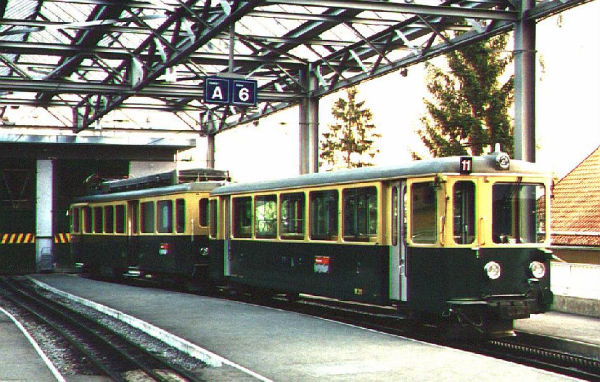
Wengernalpbahn WAB BDhe 4/4 2.series with a trailer wagon at Lauterbrunnen station.
Photo in May 1999 by Ilkka Siissalo.
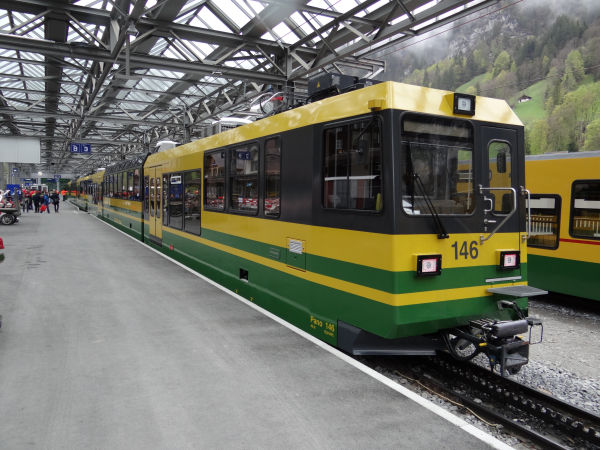
These "Pano" trains are the newest trains of WAB. It is a three coach fixed composition and two such compositions can be
coupled together, like here, to build a six coaches long train. The middle coaches of each unit have very large panorama windows
so that tourists can have a magnificent view of the surrounding mountains. The train type is officially called WAB Bhe 4/8. They were
built in two series, first in 2004 and more in 2014-15. There are now 4+6 of these new three coach multiple units. The top speed
of these trains is 28 km/h and they have 152 seats per unit. They were built by Stadler.
Photo from Lauterbrunnen station in 1.5.2016 by Ilkka Siissalo.

A closer look at the front of the "Pano" train no.150.
Photo from Lauterbrunnen station in 1.5.2016 by Ilkka Siissalo.
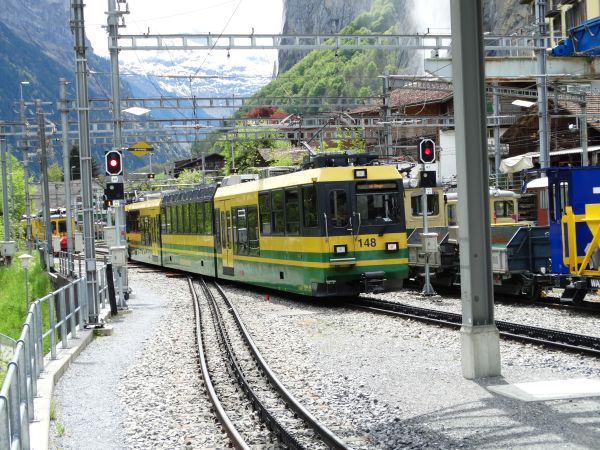
"Pano 148" is about to leave Lauterbrunnen towards Wengen - although it still has headlights on at both ends of the train. Being a Finn I can't
stop smiling at the train name PANO because in the Finnish language "Pano 148" means "fuck no.148" :-D Stadler has made trains starting from
SMILE to FLIRT, TANGO, then KISS and now PANO... :-D
Picture from Lauterbrunnen 13.5.2023 by Ilkka Siissalo

Can you spot the train? A WAB train consisting of two three coach "Pano" train units has started its climb up from Lauterbrunnen and is now already well
above the village where it started from.
Picture from Lauterbrunnen 13.5.2023 by Ilkka Siissalo
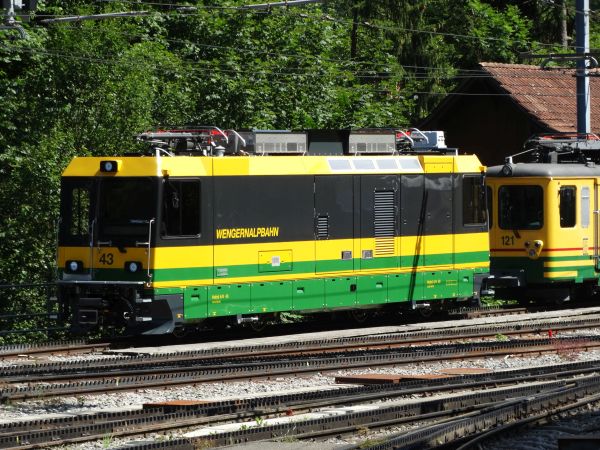
These are WAB's first really powerful and modern cargo locomotives. Built by Stadler, they were brand new when this photo was taken in July 2023. They
were by then classed as He(m) 4/4 no 43. There are three of them numbered 41-43. The "m" which indicates a diesel motor was still in brackets as the
diesel aggregate machinery had not yet been installed in the new locomotives. WAB ordered three locomotives but only one diesel aggregate unit and the
intention is to install this diesel into one or the other of the locomotives when necessary. In the naming H indicates cog wheel drive and e stands
for electric. WAB has ordered three of these new locomotives to replace the partly well over 100 years old machines still in use. They are intended
mainly for cargo trains taking care of the carless villages of Wengen and Kleine Scheidegg, but they will also be powering trains and equipment used
in track maintenance. And during major skiing events when all of WAB's trains are in full use, these may also be used in passenger traffic to power
some of the low-floor passenger coaches that WAB has.
Picture from Lauterbrunnen 13.5.2023 by Ilkka Siissalo
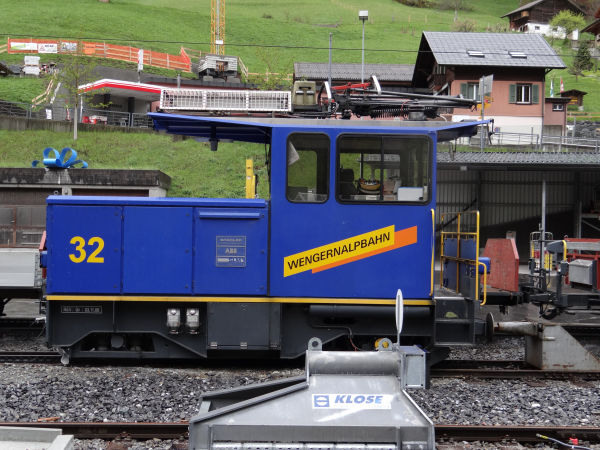
The most unique element of Wengernalpbahn operations is the freight traffic. The railway is the most prominent, if not the last
remaining railway in the world with commercial freight traffic on 800 mm gauge. The most frequently operated freight service is
between Lauterbrunnen and Wengen, as everything needs to be transported to Wengen by reloading the freight from road to rail in
Lauterbrunnen for the last bit to the village, and vice versa. The freight operation is dominated by locomotives He 2/2 31 and
32, built by Stadler, SLM and ABB in 1995. This one is the no.32.
Picture from Lauterbrunnen 1.5.2016 by Ilkka Siissalo.
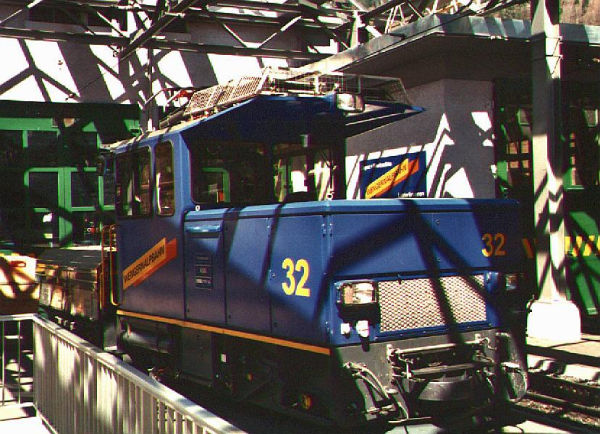
This modern freight train locomotive He 2/2 no. 32 of the Wengernalpbahn WAB is one of the two built in 1995 to replace old
and unreliable He 2/2s from the year 1909. It weighs 16 tons. Maximum speed is a modest 22 km/h.
Photo from Lauterbrunnen, May 1999 by Ilkka Siissalo.

WAB's two cargo locomotives, one from 1995 and the one behind it from 1909. Both are still in active use.
Picture from Lauterbrunnen 1.5.2016 by Ilkka Siissalo.
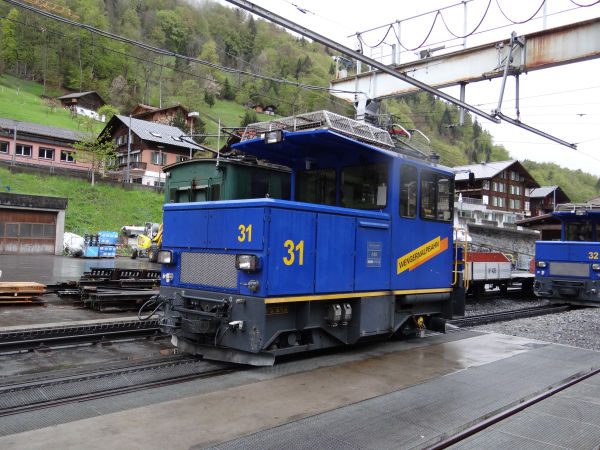
The same locomotives as shown above, but now seen from their front.
Picture from Lauterbrunnen 1.5.2016 by Ilkka Siissalo.
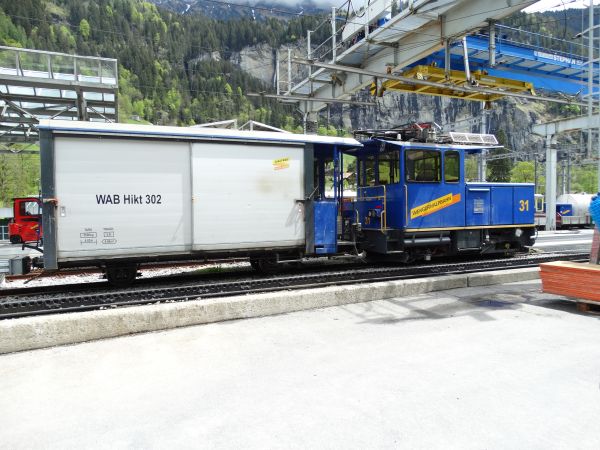
Locomotive no.31 is bringing a Hikt driver's cab wagon to the front of a cargo train.
Picture from Lauterbrunnen 13.5.2023 by Ilkka Siissalo.
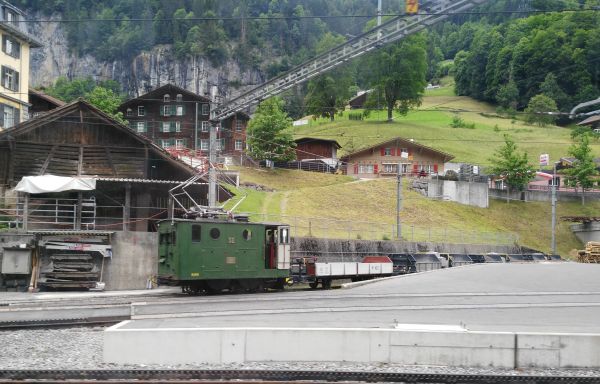
At the time of writing (July 2020), five of the older He 2/2 locomotives from 1909 to 1926 were still used in secondary
duties, including shunting operations at Lauterbrunnen and track maintenance works trains. With a maximum speed of 11 km/h
these locomotives are no longer suitable for regular passenger or freight services. Most if not all of these old locomotives
are expected to be retired with the delivery of three new He 4/4 locomotives, ordered from Stadler in early 2020. In this
picture, He 2/2 no.52 can be seen shunting at Lauterbrunnen.
Picture from Lauterbrunnen 21.6.2019 by Johannes Erra.
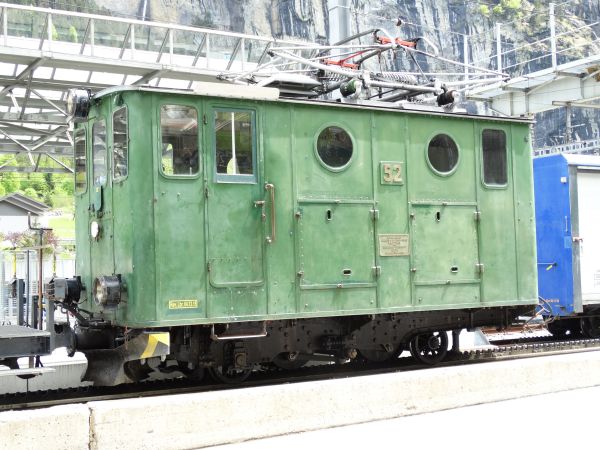
He 2/2 number 52 was in active use at Lauterbrunnen.
Picture from Lauterbrunnen 13.5.2023 by Ilkka Siissalo.
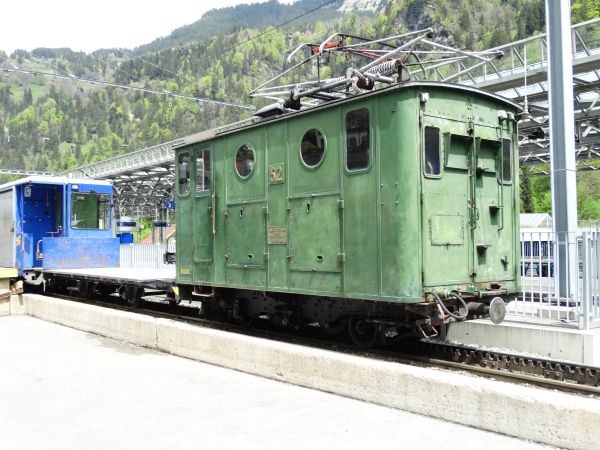
The back side of the same old locomotive He 2/2 number 52.
Picture from Lauterbrunnen 13.5.2023 by Ilkka Siissalo.

A closer look...
Picture from Lauterbrunnen 13.5.2023 by Ilkka Siissalo.

... and from its side.
Picture from Lauterbrunnen 13.5.2023 by Ilkka Siissalo.
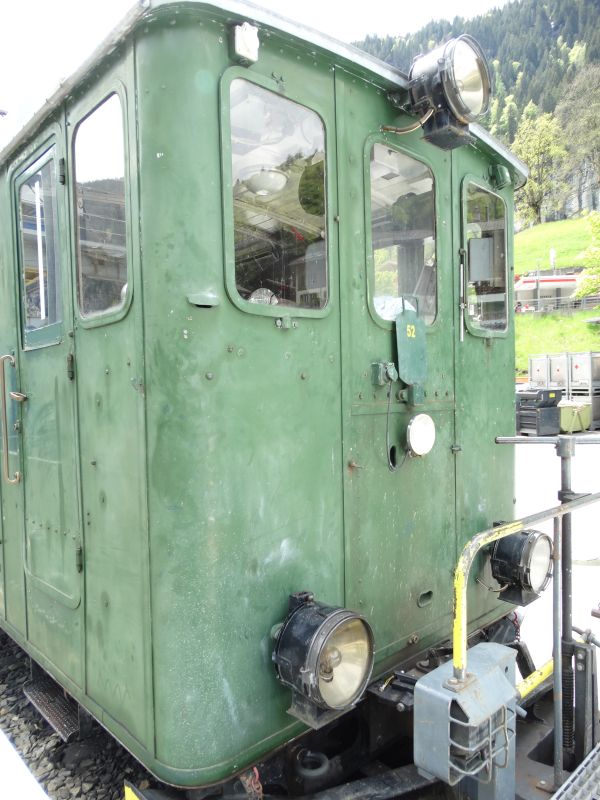
And this is once again its face seen from close by.
Picture from Lauterbrunnen 13.5.2023 by Ilkka Siissalo.

He 2/2 number 52 was here waiting for some cargo to be loaded in its cargo wagon. Then this old He 2/2 locomotive will do some shunting to turn the train around
so that a Hikt driver's cab coach will be first and the locomotive will be last. Then the train is ready to be pushed uphills.
Picture from Lauterbrunnen 13.5.2023 by Ilkka Siissalo.

"Airconditioning model 1909 fully on" = the door is as open as it gets :-D
Picture from Lauterbrunnen 11.7.2023 by Ilkka Siissalo.
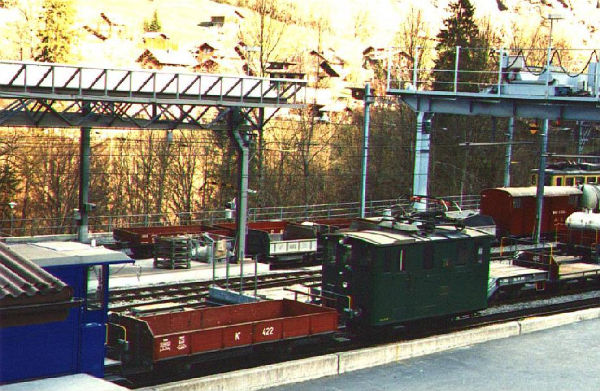
The old Wengernalpbahn WAB He 2/2 1.series locomotive no. 54 from 1909 is still in use, but
mainly only for switching wagons at the Lauterbrunnen valley station or when its two newer
siblings, He 2/2 31 and 32 from 1995 are busy. WAB bought eight of these in 1909 and a further
five in 1912. The speciality of this box-like locomotive is that its two engines are placed
very high up, which helped when they were used as electric brakes while descending the slopes.
Photo from Lauterbrunnen in May 1999 by Ilkka Siissalo.
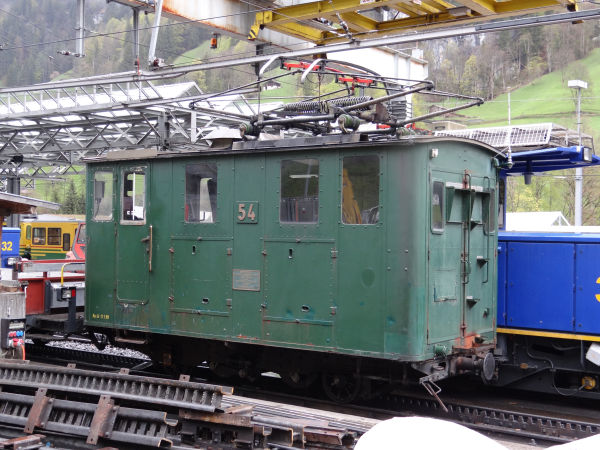
The same He 2/2 no.54 as shown above, but here seen closer by. This locomotive was built 1908 by
Schweizerische Lokomotiv- & Mashinen-Fabrik Winterthur and Elektrizitäts-Gesellschaft Alioth from Münchenstein
near Basel. For tens of years these small locomotives took care of all traffic on the WAB route.
Picture from Lauterbrunnen 1.5.2016 by Ilkka Siissalo.
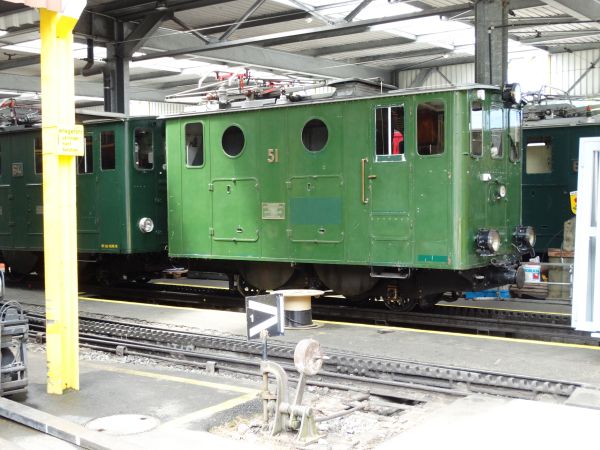
A sister machine of the one shown above, the no 51. The series of numbers 51 to 58 were built 1909-1910 (according to some other sources
1908-10) by the company Alioth in Münchenstein (later Brown Boweri) and SLM in Winterthur. There were slight differences in the machines.
The first ones of the series - like this one, which was the first one - weighed 16 tons and had a top speed of 11 km/h uphills and 12 km/h
downhills. Later machines were slightly heavier and could run even uphills at 12 km/h. There are several of these in working order and some
of them still in day to day operational use. This one, no.51 was photographed at the Wilderswil depot of the Schynige Platte Bahn. SPB rented
He 2/2 locomotives 51 and 64 together with wagons for spreading ballast gravel.
These machines were built when the railway from Wilderswil up to Lauterbrunnen and Kleine Scheidegg was electrified. Some of them
remain in active use even today serving the carless villages of Wengen and Kleine Scheidegg. On the left can be seen no.64 which is some
two years younger, from 1912. That one is also in working order.
Picture from Wilderswil 13.5.2023 by Ilkka Siissalo.
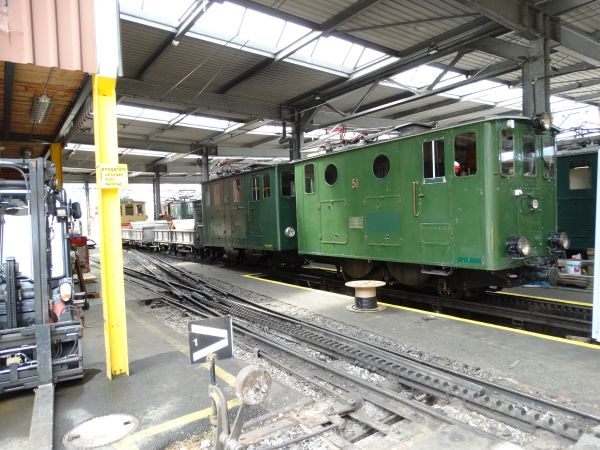
A second view of the two He 2/2 machines 51 and 64 rented by the BOB/Schynige Platte Bahn SPB. They have spent at least most of the year 2023
at the Schynige Platte Bahn, up from Wilderswil.
Picture from Wilderswil 13.5.2023 by Ilkka Siissalo.
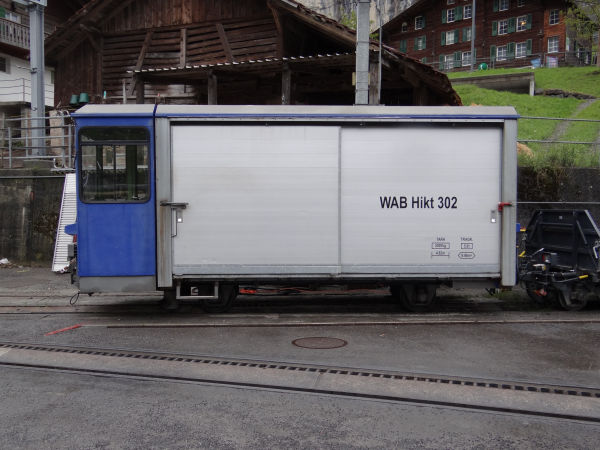
Wengernalpbahn Hikt 302 is a cog wheel drive rail truck or rather a driver's cab wagon. Since no car traffic to the village of Wengen is possible,
there is a lot of need for rail cargo equipment like this rail van. This van does not have an engine of its own, but these are puhed from behind by one
of the locomotives, but the driver is stitting in here.
Photo from Lauterbrunnen 1.5.2016 by Ilkka Siissalo.
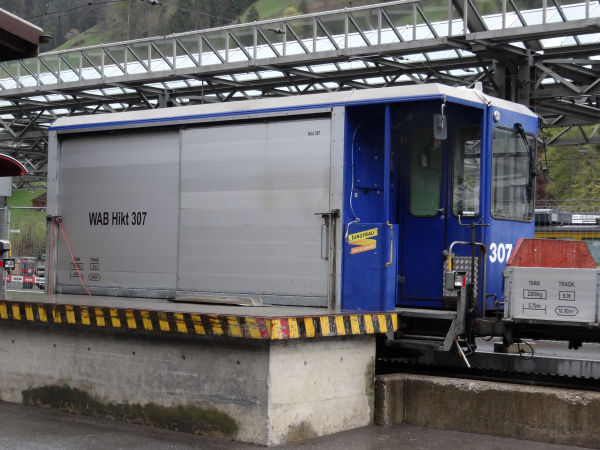
Wengernalpbahn Hikt 307 is a similar rail van like the Hikt 302 shown above. Here it is seen from the other side.
Photo from Lauterbrunnen 1.5.2016 by Ilkka Siissalo.
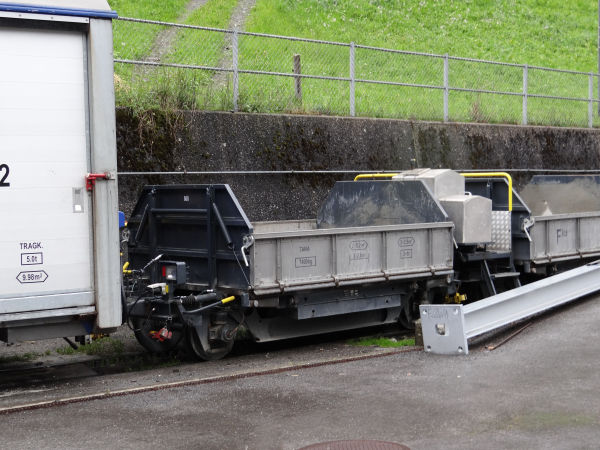
Special wagons for transportation and spreading of ballast and gravel.
Photo from Lauterbrunnen 1.5.2016 by Ilkka Siissalo.
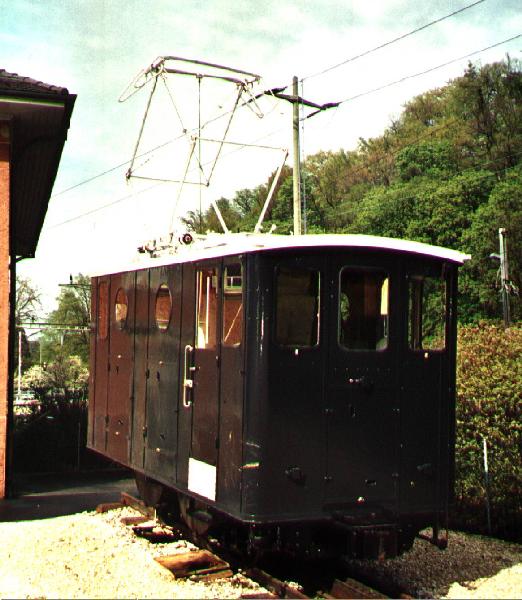
One of the Wengernalpbahn WAB He 2/2 locomotives, no. 55 from 1910 is kept as a museum piece
on the yard of the Elektra Birseck, the electricity company of Kanton Baselland. It operated
until 1969 at the Lauterbrunnen-Kleine Scheidegg-Grindelwald route, 1969-93 as no.15 at the
Schynige Plattebahn railroad, 1993-97 as a switcher engine at the WAB Lauterbrunnen station,
like its sibling no. 54 still does.
Photo from Birseck May 1999 by Ilkka Siissalo.
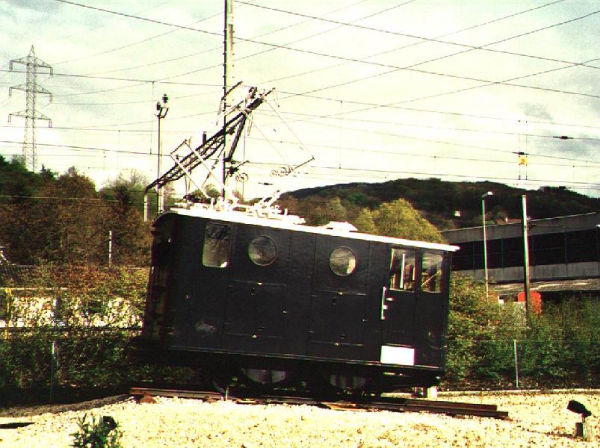
The WAB He 2/2 no 55 museum engine shown sideways. It was built mechanically at SLM,
Winterthur, in 1910 with all electrical parts from Elektrizitätsgesellschaft Alioth,
Münchenstein - a predecessor of the company whose yard it now stands on. It´s 5,75 m
long, weighs 16 tons, had a maximum speed of 12 km/h on cog wheel track and used
1500 V DC current, which is still used by WAB.
Photo from Birseck May 1999 by Ilkka Siissalo.

